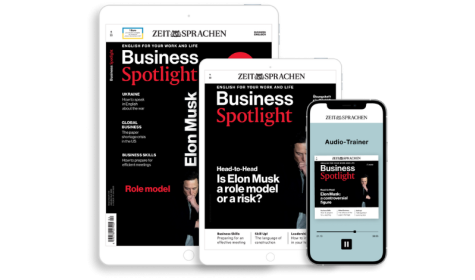Starten Sie den Audio-Text
Mit dem Audio-Player können Sie sich den Text anhören. Darunter finden Sie das Transkript.
Is your team working together as well as it could? To optimize teamwork, it’s good to take things step by step, but to take the next step, you must know where you’re heading. The missing piece for most teams is a compellingfesselnd, spannendcompelling vision of a bright future for how the team can work together best. The clearer and more attractive that vision is, the easier and more enjoyable the next step becomes. Here’s how to guide your team through this process:
Step 1: create the ideal future
Allow two to three hours for this workshop — preferably as an afternoon off-sitehier: außerhalb des Bürosoff-site. Divide the team into breakout groupArbeitsgruppe, Untergruppebreakout groups of four to five people. Each group will need its own space to work on their vision of the future.
Start with a quick warm-up such as a check-in questionEingangsfrage (zur Einbeziehung der Teilnehmer(innen))check-in question or a physical activity to get people get sb. engagedhier: jmdn. zum Mitmachen motivierenengaged. Then, have everyone stand in a circle and have them imagine the future: “Imagine it’s one year from now. Tonight, there’s a party celebrating the Team of the Year, and the winner is already known — it’s you. Before the party, you have a press conference schedule sth.etw. planen, anberaumenscheduled an hour from now, in which you should present your success story. How do you work together now? What key milestones did you achieve? What challenges did you overcome? What are you most proud of? Your task is to prepare a 15-minute presentation. Afterwards, the audienceZuhörer(innen)audience will ask questions.”
Step 2: prepare the presentations
Make sure everyone understands the task. Then, set the timer for an hour and have the groups start work.
There should be enough material available for the group to work with — flip charts, pinboards, markers, etc. You won’t necessarily need laptops, but if you have people who are be savvy with sth. (ifml.)sich gut mit etw. auskennensavvy with presentation software, allow them the freedom to present their story the way they want.
As you are part of the team, you should join in. It’s not ideal to have someone in two roles — as moderator and team member — so you might want to have somebody from outside play the role of moderator. This could be a colleague from another department or a trained external facilitatorSitzungsleiter(in), Moderator(in)facilitator, for example. The moderator helps the teams with their task and makes sure they keep an eye on sth.etw. im Auge behalten, auf etw. achtenkeep an eye on the time. While an hour might sound like a long time, in my experience, most teams find it quite challenging to finish within that time.
Step 3: present the future
Bring everyone back together. The room should be set up like a press conference, with the presenting team at the front and rows of chairs for the “journalists”.
Have the first group present their success story. They should speak as though it’s already the future, in present and past tense. This is to reinforce sth.etw. verstärkenreinforce the feeling of “we made it”, which should get everyone feeling good.
After the presentation, invite sb.hier: jmdn. aufforderninvite the “journalists” to ask their questions. Encourage them to play their roles seriously and to have fun with it: “Hello, I’m Matt from Gratitude Daily. Great achievement, everyone. Looking back over the past year, what are you most thankful for? How did you arrive at your solutions? Describe your greatest challenge.”
If people need inspiration, you can offer additional promptStichwortprompts to spark sth.etw. auslösen; hier: hervorrufenspark further questions. Once the first group has finished, it’s the next group’s turn to present and the previousvorherigprevious presenters become the journalists.
Step 4: reflect and plan
After all the presentations, bring everyone back to the present. Lead a reflection round by asking: “How did you feel? What was surprising? What have you learned about your team?” Make sure everyone shares their thoughts.
The results from the groups will play a crucialwesentlichcrucial role in shaping the next steps. As a team, review sth.etw. überprüfenreview the various approachVorgehensweiseapproaches and come up with a concrete plan for the future. Ask the team: “What is your plan to reach this ideal future? What’s one important next step you want to take?”
At this point, the team should work on the plan together. After having gone through the process of visualizing their ideal future, deciding on the next step ought to be a lot easier. And it’s fun and exciting.
In the end, the team will have a clear vision, an inspiring goal to work towards and concrete steps to take in the near future. This gives your team structure, and direction. That’s not bad for a few hours of work, right?
Neugierig auf mehr?
Dann nutzen Sie die Möglichkeit und stellen Sie sich Ihr optimales Abo ganz nach Ihren Wünschen zusammen.



